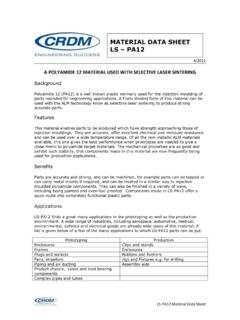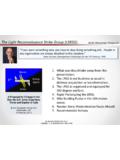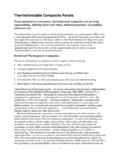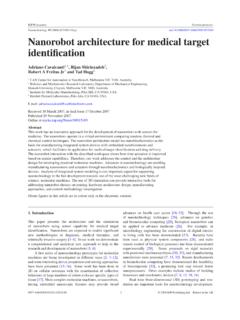Transcription of MineWest- Belt Conveyor Reliability
1 INCREASING belt Conveyor Reliability THROUGH VIRTUAL prototyping Bud Viren, Vice President Overland Conveyor Co., Inc. 21 Ox Yoke Trail Carlile, WY 82721-8706 307-756-3893 307-756-3231 Fax Mark A. Alspaugh, President Overland Conveyor Co., Inc. 12640 W Cedar Dr Suite D Lakewood, CO 80228 303-973-7357 303-217-5208 Fax Abstract belt conveyors are complex because every application is unique. And since a physical prototype of a miles-long machine is impractical, other types of advanced design techniques are necessary to ensure a Conveyor will run reliably for many years. Recent advances in numerical simulation techniques are leading to increasingly more realistic Virtual Prototypes which are leading to significant changes in system and component designs.
2 The application of time- based, numerical modeling tools that consider belt elasticity as well as discrete, particle-based bulk material flow methods are giving engineers unprecedented looks at expected performance early in the design cycle when changes are easy and affordable. Examples of belt conveying applications along with numerical tools required to ensure Reliability and availability will be reviewed. Complexity Miners are continually seeking increased throughput of bulk materials at lower cost. And equipment manufacturers are continuing to provide this with larger and larger machines with more control options, and greater automation. Driven by this market demand, engineers and OEMs are continuously working to improve their products, delivering more features and innovations to set themselves apart from the crowd and stay ahead of demand.
3 This usually means incorporating the newest technology and the result is always greater complexity. In a recent survey of product designers and engineers published by a prominent magazine, 42% identified design and product complexity as the most important issue they face; well ahead of time-to-market pressures (13%), competitive pressure (12%), and cost reduction (11%). And engineering is in the midst of a continuing explosion of complexity. All types of products including cars, computers, and even toasters are more complex than they were ten years ago. But greater complexity brings both new benefits and new problems. For example, new cars can include amazing technology that can tell you where you are and where you should be, but when they break down, they do so in strange new ways that most drivers don t understand.
4 Unfortunately, everyone agrees these trends will not be changing any time soon. And all the new wonderful technology in the world is worthless if we cannot produce reliable equipment. Therefore, the implications of this complexification require we develop new techniques and strategies for engineering complex systems that deal with these problems. Design Testing Today s huge mining machinery share another common characteristic in that final assembly occurs at the mine. These machines are too big to be assembled and tested before hand. Although sub-systems and components are tested, the assembled machine (system) is commissioned and expected to perform almost immediately. Overland belt Conveyor engineers face an even more difficult task as most every major conveyance systems is totally unique in system design.
5 And today, the many components that must all interact together properly for the Conveyor system to function are often manufactured all over the world and only interface during commissioning. Reliability and Availability belt conveyors are used in mining because they are an economical way to move bulk materials over distances up to many miles. But because a Conveyor delivers a very small amount of material over long periods of time, it is essential they operate efficiently with maximum availability and minimum downtime. Unlike a truck or train that delivers large loads intermittently, a Conveyor must deliver a small, steady stream of material continually. Therefore, reliable and available equipment is absolutely essential in Conveyor system design.
6 System Availability System availability is calculated by modeling the system as an interconnection of parts in series and parallel. If failure of a part leads to the combination of parts becoming inoperable, the two parts are considered to be operating in series. This is typical of a Conveyor or series of conveyors as a single part failure will stop the whole system and stop throughput. If failure of a part leads to another part taking over the operations of the failed part, the two parts are considered to be operating in parallel. This would be typical of a fleet of trucks. Availability in Parallel As stated above, two parts are considered to be operating in parallel if the combination is considered failed when both parts fail.
7 The combined system is operational if either is available. From this it follows that the combined availability is 1 - (both parts are unavailable). The combined availability is shown by the equation below: The implications of the above equation are that the combined availability of two components in parallel is always much higher than the availability of its individual components. Consider the system in the figure above. Two instances of Part X are connected in parallel. The table below shows the availability and downtime for individual components and the parallel combination considering a nominal 6000 hours of operation a year. Component Availability Downtime X 95% 16 days/year Combined System 1 day/year From the above table it is clear that even though a very low availability Part X was used, the overall availability of the system is much higher.
8 Thus, parallel operation provides a very powerful mechanism for making a highly reliable system from low Reliability . Availability in Series As stated above, two parts X and Y are considered to be operating in series if failure of either of the parts results in failure of the combination. The combined system is operational only if both Part X and Part Y are available. From this it follows that the combined availability is a product of the availability of the two parts. The combined availability is shown by the equation below: The implications of the above equation are that the combined availability of two components in series is always lower than the availability of its individual components. Consider the system in the figure above.
9 Part X and Y are connected in series. The table below shows the availability and downtime for individual components and the series combination considering the same nominal 6000 hours of operation a year. From the above table, it is clear that even though a very high availability Part Y was used, the overall availability of the system was pulled down by the low availability of Part X. This just proves the saying that a chain is as strong as the weakest link. More specifically, a chain is weaker than the weakest link. Therefore designing a highly reliable Conveyor system requires the elimination of all weak links. Failures Equipment failures over equipment life is sometimes characterized by a bath tub curve (example curve is shown below).
10 The chance of a hardware failure is high during the initial life of the machine. The failure rate during the rated useful life of the product is fairly low. Once the end of the life is reached, failure rates increase again. Most owners understand the small rate of failure during the Useful Life phase which is why stores of critical spare parts are maintained. And most of us understand that failures increase near the End of Life (which usually defines the End of Life ). But it is much harder for many to understand the reasons for a high Infant Mortality. Because these huge machines cost a lot of money, they are expected to perform accordingly. Yet Infant Mortality can still be high and frustrating because management is always anxious to see results of their huge investment.








